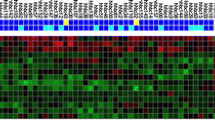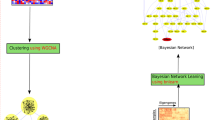Abstract
Using a machine learning method, this study aimed to identify unique causal networks of genes associated with bone, brain, and lung metastasis of breast cancer. Bayesian network analysis identified differentially expressed genes in primary breast cancer tissues, in bone, brain, and lung breast cancer metastatic tissues, and the clinicopathological features of patients obtained from the Gene Expression Omnibus microarray datasets. We evaluated the causal Bayesian networks of breast metastasis to distant sites (bone, brain, or lung) by (i) measuring how well the structures of each specific type of breast cancer metastasis fit the data, (ii) comparing the structures with known experimental evidence, and (iii) reporting predictive capabilities of the structures. We report for the first time that the molecular gene signatures are specific to the different types of breast cancer metastasis. Several genes, including CHPF, ARC, ANGPTL4, NR2E1, SH2D1A, CTSW, POLR2J4, SPTLC1, ILK, ALDH3B1, PDE6A, SCTR, ADM, HEY1, KCNF1, and UVRAG, were found to be predictors of the risk for site-specific metastasis of breast cancer. Expression of POLR2JA, SPTLC1, ILK, ALDH3B1, and the estrogen receptor was significantly associated with breast cancer bone metastasis. Expression of PDE6A and NR2E1 was causally linked to breast cancer brain metastasis. Expression of HEY1, KCNF1, UVRAG, and the estrogen and progesterone receptors was strongly associated with breast cancer lung metastasis. The causal Bayesian network structures of these genes identify potential interactions among the genes in distant metastases of breast cancer, including to the bone, brain, and lung, and may serve as target candidates for treatment of breast cancer metastasis.








Similar content being viewed by others
References
Cosphiadi I, Atmakusumah TD, Siregar NC, Muthalib A, Harahap A, Mansyur M (2018) Bone metastasis in advanced breast cancer: analysis of gene expression microarray. Clin Breast Cancer 18:e1117–e1122. https://doi.org/10.1016/j.clbc.2018.03.001
Jin X, Mu P (2015) Targeting breast cancer. Metastasis Breast Cancer (Auckl) 9:23–34. https://doi.org/10.4137/BCBCR.S25460
Carioli G, Malvezzi M, Rodriguez T, Bertuccio P, Negri E, La Vecchia C (2018) Trends and predictions to 2020 in breast cancer mortality: Americas and Australasia. Breast 37:163–169. https://doi.org/10.1016/j.breast.2017.12.004
Waks AG, Winer EP (2019) Breast cancer treatment: a review. JAMA 321:288–300. https://doi.org/10.1001/jama.2018.19323
Patanaphan V, Salazar OM, Risco R (1988) Breast cancer: metastatic patterns and their prognosis. South Med J 81:1109–1112
Gupta GP, Massague J (2006) Cancer metastasis: building a framework. Cell 127:679–695. https://doi.org/10.1016/j.cell.2006.11.001
Randall RL (2014) A promise to our patients with metastatic bone disease. Ann Surg Oncol 21:4049–4050. https://doi.org/10.1245/s10434-014-4010-1
Chavez-MacGregor M, Mittendorf EA, Clarke CA, Lichtensztajn DY, Hunt KK, Giordano SH (2017) Incorporating tumor characteristics to the American Joint Committee on Cancer Breast Cancer Staging System. Oncologist 22:1292–1300. https://doi.org/10.1634/theoncologist.2017-0116
Bardia A, Mayer IA, Diamond JR, Moroose RL, Isakoff SJ, Starodub AN, Shah NC, O’Shaughnessy J, Kalinsky K, Guarino M, Abramson V, Juric D, Tolaney SM, Berlin J, Messersmith WA, Ocean AJ, Wegener WA, Maliakal P, Sharkey RM, Govindan SV, Goldenberg DM, Vahdat LT (2017) Efficacy and safety of Anti-Trop-2 antibody drug conjugate sacituzumab govitecan (IMMU-132) in heavily pretreated patients with metastatic triple-negative breast cancer. J Clin Oncol 35:2141–2148. https://doi.org/10.1200/JCO.2016.70.8297
Swain SM, Baselga J, Kim SB, Ro J, Semiglazov V, Campone M, Ciruelos E, Ferrero JM, Schneeweiss A, Heeson S, Clark E, Ross G, Benyunes MC, Cortes J, CLEOPATRA Study Group (2015) Pertuzumab, trastuzumab, and docetaxel in HER2-positive metastatic breast cancer. N Engl J Med 372:724–734. https://doi.org/10.1056/NEJMoa1413513
Aktas B, Kasimir-Bauer S, Muller V, Janni W, Fehm T, Wallwiener D, Pantel K, Tewes M, CLEOPATRA Study Group (2016) Comparison of the HER2, estrogen and progesterone receptor expression profile of primary tumor, metastases and circulating tumor cells in metastatic breast cancer patients. BMC Cancer 16:522. https://doi.org/10.1186/s12885-016-2587-4
Cardoso F, Bedard PL, Winer EP, Pagani O, Senkus-Konefka E, Fallowfield LJ, Kyriakides S, Costa A, Cufer T, Albain KS, Force E-MT (2009) International guidelines for management of metastatic breast cancer: combination vs sequential single-agent chemotherapy. J Natl Cancer Inst 101:1174–1181. https://doi.org/10.1093/jnci/djp235
Robson M, Im SA, Senkus E, Xu B, Domchek SM, Masuda N, Delaloge S, Li W, Tung N, Armstrong A, Wu W, Goessl C, Runswick S, Conte P (2017) Olaparib for metastatic breast cancer in patients with a germline BRCA mutation. N Engl J Med 377:523–533. https://doi.org/10.1056/NEJMoa1706450
Fribbens C, O’Leary B, Kilburn L, Hrebien S, Garcia-Murillas I, Beaney M, Cristofanilli M, Andre F, Loi S, Loibl S, Jiang J, Bartlett CH, Koehler M, Dowsett M, Bliss JM, Johnston SR, Turner NC (2016) Plasma ESR1 mutations and the treatment of estrogen receptor-positive advanced breast cancer. J Clin Oncol 34:2961–2968. https://doi.org/10.1200/JCO.2016.67.3061
Mittempergher L, Saghatchian M, Wolf DM, Michiels S, Canisius S, Dessen P, Delaloge S, Lazar V, Benz SC, Tursz T, Bernards R, van’t Veer LJ (2013) A gene signature for late distant metastasis in breast cancer identifies a potential mechanism of late recurrences. Mol Oncol 7:987–999. https://doi.org/10.1016/j.molonc.2013.07.006
Wang Y, Klijn JG, Zhang Y, Sieuwerts AM, Look MP, Yang F, Talantov D, Timmermans M, Meijer-van Gelder ME, Yu J, Jatkoe T, Berns EM, Atkins D, Foekens JA (2005) Gene-expression profiles to predict distant metastasis of lymph-node-negative primary breast cancer. Lancet 365:671–679. https://doi.org/10.1016/S0140-6736(05)17947-1
Fazilaty H, Mehdipour P (2014) Genetics of breast cancer bone metastasis: a sequential multistep pattern. Clin Exp Metastasis 31:595–612. https://doi.org/10.1007/s10585-014-9642-9
Su G, Morris JH, Demchak B, Bader GD (2014) Biological network exploration with Cytoscape 3. Curr Protoc Bioinformatics 47:8.13.1-8.13.24. https://doi.org/10.1002/0471250953.bi0813s47
Deo RC, Nallamothu BK (2016) Learning about machine learning: the promise and pitfalls of big data and the electronic health record. Circ Cardiovasc Qual 9:618–620. https://doi.org/10.1161/Circoutcomes.116.003308
Nemzek JA, Hodges AP, He Y (2015) Bayesian network analysis of multi-compartmentalized immune responses in a murine model of sepsis and direct lung injury. BMC Res Notes 8:516. https://doi.org/10.1186/s13104-015-1488-y
Park SB, Chung CK, Gonzalez E, Yoo C (2018) Causal inference network of genes related with bone metastasis of breast cancer and osteoblasts using causal Bayesian networks. J Bone Metab 25:251–266. https://doi.org/10.11005/jbm.2018.25.4.251
Barrett T, Wilhite SE, Ledoux P, Evangelista C, Kim IF, Tomashevsky M, Marshall KA, Phillippy KH, Sherman PM, Holko M, Yefanov A, Lee H, Zhang N, Robertson CL, Serova N, Davis S, Soboleva A (2013) NCBI GEO: archive for functional genomics data sets—update. Nucleic Acids Res 41:D991-995. https://doi.org/10.1093/nar/gks1193
Lipton A, Theriault RL, Hortobagyi GN, Simeone J, Knight RD, Mellars K, Reitsma DJ, Heffernan M, Seaman JJ (2000) Pamidronate prevents skeletal complications and is effective palliative treatment in women with breast carcinoma and osteolytic bone metastases: long term follow-up of two randomized, placebo-controlled trials. Cancer 88:1082–1090
Friedman N, Koller D (2003) Being Bayesian about network structure. A Bayesian approach to structure discovery in Bayesian networks. Mach Learn 50:95–125. https://doi.org/10.1023/A:1020249912095
Agostinho NB, Machado KS, Werhli AV (2015) Inference of regulatory networks with a convergence improved MCMC sampler. BMC Bioinformatics 16:306. https://doi.org/10.1186/s12859-015-0734-6
Scutari MDJ (2014) Bayesian networks with examples in R. Chapman and Hall, Boca Raton, p 16
Charniak E (1991) Bayesian networks without tears. Ai Mag 12:50–63
Siclari VA, Mohammad KS, Tompkins DR, Davis H, McKenna CR, Peng X, Wessner LL, Niewolna M, Guise TA, Suvannasankha A, Chirgwin JM (2014) Tumor-expressed adrenomedullin accelerates breast cancer bone metastasis. Breast Cancer Res 16:458. https://doi.org/10.1186/s13058-014-0458-y
Ferrero H, Larrayoz IM, Gil-Bea FJ, Martinez A, Ramirez MJ (2018) Adrenomedullin, a novel target for neurodegenerative diseases. Mol Neurobiol 55:8799–8814. https://doi.org/10.1007/s12035-018-1031-y
Shafik NM, Mohamed DA, Bedder AE, El-Gendy AM (2015) Significance of tissue expression and serum levels of angiopoietin-like protein 4 in breast cancer progression: link to NF-kappaB /P65 activity and pro-inflammatory cytokines. Asian Pac J Cancer Prev 16:8579–8587
Sobhan PK, Funa K (2017) TLX—its emerging role for neurogenesis in health and disease. Mol Neurobiol 54:272–280. https://doi.org/10.1007/s12035-015-9608-1
Lin ML, Patel H, Remenyi J, Banerji CR, Lai CF, Periyasamy M, Lombardo Y, Busonero C, Ottaviani S, Passey A, Quinlan PR, Purdie CA, Jordan LB, Thompson AM, Finn RS, Rueda OM, Caldas C, Gil J, Coombes RC, Fuller-Pace FV, Teschendorff AE, Buluwela L, Ali S (2015) Expression profiling of nuclear receptors in breast cancer identifies TLX as a mediator of growth and invasion in triple-negative breast cancer. Oncotarget 6:21685–21703. https://doi.org/10.18632/oncotarget.3942
Tan GJ, Peng ZK, Lu JP, Tang FQ (2013) Cathepsins mediate tumor metastasis. World J Biol Chem 4:91–101. https://doi.org/10.4331/wjbc.v4.i4.91
Winslow S, Leandersson K, Edsjo A, Larsson C (2015) Prognostic stromal gene signatures in breast cancer. Breast Cancer Res 17:23. https://doi.org/10.1186/s13058-015-0530-2
Hou XM, Zhang T, Da Z, Wu XA (2019) CHPF promotes lung adenocarcinoma proliferation and anti-apoptosis via the MAPK pathway. Pathol Res Pract. https://doi.org/10.1016/j.prp.2019.02.005
Toth C, Meinrath J, Herpel E, Derix J, Fries J, Buettner R, Schirmacher P, Heikaus S (2016) Expression of the apoptosis repressor with caspase recruitment domain (ARC) in liver metastasis of colorectal cancer and its correlation with DNA mismatch repair proteins and p53. J Cancer Res Clin Oncol 142:927–935. https://doi.org/10.1007/s00432-015-2102-3
Gu JX, Zhang X, Miao RC, Xiang XH, Fu YN, Zhang JY, Liu C, Qu K (2019) Six-long non-coding RNA signature predicts recurrence-free survival in hepatocellular carcinoma. World J Gastroenterol 25:220–232. https://doi.org/10.3748/wjg.v25.i2.220
Oloumi A, Maidan M, Lock FE, Tearle H, McKinney S, Muller WJ, Aparicio SA, Dedhar S (2010) Cooperative signaling between Wnt1 and integrin-linked kinase induces accelerated breast tumor development. Breast Cancer Res 12:R38. https://doi.org/10.1186/bcr2592
Acconcia F, Manavathi B, Mascarenhas J, Talukder AH, Mills G, Kumar R (2006) An inherent role of integrin-linked kinase-estrogen receptor alpha interaction in cell migration. Cancer Res 66:11030–11038. https://doi.org/10.1158/0008-5472.CAN-06-2676
Kang S, Kim B, Kang HS, Jeong G, Bae H, Lee H, Lee S, Kim SJ (2015) SCTR regulates cell cycle-related genes toward anti-proliferation in normal breast cells while having pro-proliferation activity in breast cancer cells. Int J Oncol 47:1923–1931. https://doi.org/10.3892/ijo.2015.3164
Wu T, Li Y, Gong L, Lu JG, Du XL, Zhang WD, He XL, Wang JQ (2012) Multi-step process of human breast carcinogenesis: a role for BRCA1, BECN1, CCND1, PTEN and UVRAG. Mol Med Rep 5:305–312. https://doi.org/10.3892/mmr.2011.634
McFall T, McKnight B, Rosati R, Kim S, Huang Y, Viola-Villegas N, Ratnam M (2018) Progesterone receptor A promotes invasiveness and metastasis of luminal breast cancer by suppressing regulation of critical microRNAs by estrogen. J Biol Chem 293:1163–1177. https://doi.org/10.1074/jbc.M117.812438
Author information
Authors and Affiliations
Contributions
SBP has contribution to the design of the work and acquisition, analysis and interpretation of data. And he has drafted the work. KH has drafted the work. CKC has contribution to the design of the work. DR and CY have contribution to the conception of the work, interpretation of data and revised the draft.
Corresponding authors
Ethics declarations
Conflict of interest
The authors declare that they have no conflict of interest.
Additional information
Publisher's Note
Springer Nature remains neutral with regard to jurisdictional claims in published maps and institutional affiliations.
Rights and permissions
About this article
Cite this article
Park, S.B., Hwang, KT., Chung, C.K. et al. Causal Bayesian gene networks associated with bone, brain and lung metastasis of breast cancer. Clin Exp Metastasis 37, 657–674 (2020). https://doi.org/10.1007/s10585-020-10060-0
Received:
Accepted:
Published:
Issue Date:
DOI: https://doi.org/10.1007/s10585-020-10060-0




